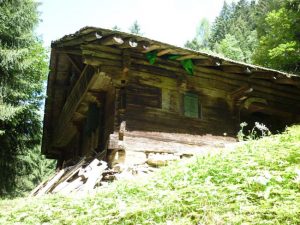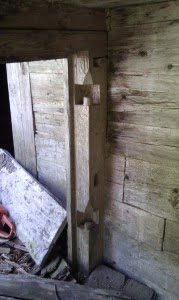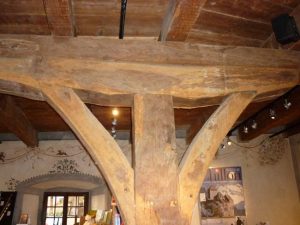
A blog by Ali Easton (of Organic Geometry) and Anselm Fraser (Principal of the International Chippendale School of Furniture) about their working holiday restoring a Swiss chalet.
“Don’t get me wrong, I love my workshop in the Chippendale Incubation Centre. Looking south, I can raise my eyes from my vice and see the quiet woods and tended fields of East Lothian climb towards the Lammermuir hills that roll over the horizon. I’m a lucky man. But I was given an offer that would take me away from that and jumped at the chance.
“I’ve spent the last two years changing my daily life. I’ve moved from a desk to a work-bench, from Powerpoint to power-tools. I gave up my life as a project manager in technology, retrained and became a furniture designer and maker, running my own one-man furniture business.
“The offer came from my woodworking teacher and now mentor, Anselm Fraser. He stuck his head round the door and said there was some work I might be interested in. Why don’t I join him in Switzerland for a week or so, working on the restoration of some very old farmhouse chalets in the glorious mountains south of Lake Geneva. The Alps trump the Lammermuirs.
“My new life has centred completely around bespoke furniture, often meaning small scale and delicate; a world of fine joints, millimetre accuracy and transparent shavings from a terrifingly sharp plane. But as a woodworker it’s impossible not to be seduced by almost all forms of the craft. Buildings and the process of building with wood had begun to fascinate me almost from the moment I began my training. And anyway, who’s not a sucker for a beautiful Swiss chalet? The chance to work on one, in fact, to save it from ruin, to savour the rustic elegance of its lines, and feel the weathered Alpine pine on the blade, was an offer I could not refuse.
“Robert Louis Stevenson famously said ‘to travel hopefully is a better thing than to arrive, and the true success is to labour.’ I travelled hopeful of learning, hopeful of broadening my woodworking experience. More prosaically though, I knew there would be some serious labour.

“It turned out to be a hugely enriching experience. Though, as anyone who has travelled to Switzerland will guess, not in a monetary sense. I was inundated with new ideas, new ways of working, and new techniques in wood. But of course these ideas were as old as the hills and had been known to the Swiss farmers who have lived for generations in these mountains. I just needed my eyes and let it all flood in, and what it gave me was a great respect for the people who had made what I was restoring.
“Staircases, consisting of two straight beams, laid across with great wedges of pine to form the treads, cut from sections of the round log, quartered along its length. Simple and quick to make, requiring so few tools.
“Massive roof rafters, simply felled trees, de-barked and hefted into place with manpower alone.
“Huge door hinges made entirely of wood, the vertical pins formed by carving away timber from the thick door jamb. And the matching barrel, a hole drilled in the horizontal rails on the door. The door simply drops into place, the barrels falling down over the pins. No metal work required, no screws to buy, so few tools required to make it. So elegant!
“These ancient solutions to everyday problems of living and shelter on a high Swiss mountainside have lots to say to us today. Firstly, these houses were built by the families who went on to live in them. In today’s world, surrounded by a dry, long-winded public debate about the benefits of university versus vocational studies, it’s refreshing to see that some people recognised what skills they needed to live life and just got on with it.
“Secondly, materials were local. Even today there’s no road in to these upper houses, just a very steep path through a forest. If you wanted to bring materials in then you would have to carry them on your back. It made sense to use what was around you, and in turn to manage the landscape carefully to ensure those materials were always going to be available. The forest is fuel, building materials, avalanche protection.
“In the modern building trade timber is considered one of the greenest building materials. The people who built these houses knew it instinctively and their descendents today still manage the forest with the long view, with intelligence and respect. The result: nature provides infinitely.

“And waste is easily dealt with because almost everything was wood. Left in the open uncovered it will quickly rot back into the ground. Nutrients return to the soil and no landfill problems to worry about.
“I spent my time there soaking up the influences and ideas, enjoying the low-tech but ingenious designs, and realizing how these people had been able to build houses, furnish them and live in relative harmony with their environment.
“So having returned to my own furniture workshop, with the Lammermuirs again on the horizon, I reflect on the trip and what it means for wood craft here in modern Scotland. While the ancient Caledonian forest is largely gone, Scotland does have forests of both conifer and broadleaf, and the old rule still applies: if managed well, nature will provide infinitely.
“I work almost entirely in wood that comes from within 30 miles of my workshop. Locally we have some fabulous oak, elm, ash and sycamore, all with beautiful grain and figure (there’s some speculation that that’s a result of the battering these Scottish trees have taken from the weather). And there’s a vibrant scene of crafts people working all around the nation, from green oak house-frame builders, through unique bespoke furniture workshops to wooden jewellery makers.
“Local materials, local knowledge and local crafts people make a powerful combination, especially when inspired by the best the world has to offer. So by all means travel to Switzerland – you’ll love it – but you’ll find some beautiful wood craft on your own doorstep.”
Anselm Fraser, the Principal of the Chippendale School of Furniture, adds:
“Ali Easton, Graham Davies (one of the Furniture School’s tutors) and I had an inspiring time in Switzerland. A working holiday expands your horizons, and you come back refreshed, more creative and more profitable.
“Every year I do some building work, always during the summer months because I love being outside in the sunshine. One of the objectives of the course that I run at the Chippendale International School of Furniture is to show my students the big picture and that life is not about working solidly at the bench for 45 weeks of the year. How about only 35 weeks?
“To achieve this you need to diversify your business: making furniture is work, but using your woodworking skills overseas, building and restoring a wooden chalet is not really work and spices up your year!
“I like to open up the eyes of recent graduates to the many interesting things you can do with woodworking skills.

“When setting up your business you are supposed to write a business plan but that can be challenging when you can’t foretell the future of your business. You need more time, so we have a Business Incubation Centre at the school where recent graduates benefit from subsidised workshop space, and access to tools, machinery and some mentoring.”